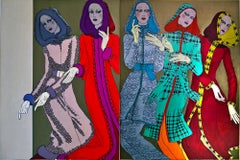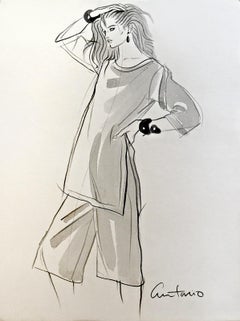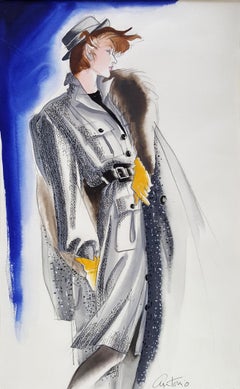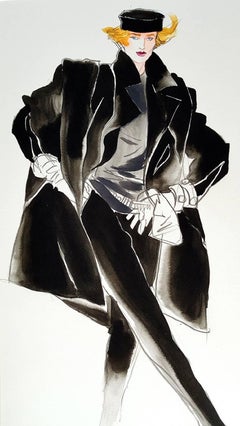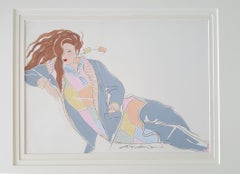Figurative Drawings and Watercolors
to
8
7
1
4
3
1
Overall Height
to
Overall Width
to
2
2
1
1
1
8
6
6
5
4
3
2
2
8
1
7
29
671
326
198
132
7
7
5
4
1
Figurative Drawings and Watercolors For Sale
Artist: Antonio Lopez
Five Fashion Models Wearing Hoodies Vogue Patterns 1970s Fashion - Puerto Rican
Located in Miami, FL
Famed Puerto Rican Fashion Illustrator Antonio Lopez creates an oversized illustration for Vogue Patterns Magazine 1971. He uses a variety of media whic...
Category
1970s Modern Figurative Drawings and Watercolors
Materials
Paper, Watercolor, Mixed Media
Fashion Model full figure in profile
Located in Miami, FL
Fashion Illustration. Work is unframed. Free standing heavy watercolor paper loosely hinged to board. Excellent condition.
Category
1980s Contemporary Figurative Drawings and Watercolors
Materials
Watercolor, Pencil
Vogue Magazine, Elegant Fashion Illustration for Adel Simpson
Located in Miami, FL
Vogue USA, Fashion Illustration. Meticulously drawn in a descriptive and yet creative way. Antonio's full mastery of his art is on full display. Signed lower right. The work is arch...
Category
1980s Post-Impressionist Figurative Drawings and Watercolors
Materials
Gouache, Watercolor, Pencil
Stylish 80's Women, Fashion Illustration
Located in Miami, FL
Work is not framed. Done for a Manhattan fashion house in the 1980's
Category
1980s Figurative Drawings and Watercolors
Materials
Ink, Watercolor, Pencil
Vogue Magazine Hi Fashion Illustration (Stephen Sprouse)
Located in Miami, FL
Vogue Magazine Fashion Illustration (Stephen Sprouse)
Antonio's mature style is on full display with a few quick strokes of the brush he is exemplifying the epitome of style and clas...
Category
1980s Impressionist Figurative Drawings and Watercolors
Materials
Gouache
Art Deco Style Fashion Illustration for High Fashion Magazine, Vogue Magazine?
Located in Miami, FL
Fashion Illustration for High Fashion Magazine . Impeccably rendered with quick flat brush strokes in glorious pastel colors , Signed lower right Ant...
Category
1980s Art Deco Figurative Drawings and Watercolors
Materials
Gouache, Pencil
Vogue USA, Fashion Illustration
Located in Miami, FL
Vogue USA, Fashion Illustration. Meticulously drawn in a descriptive and yet creative way. Antonio's full mastery of his art is on full display...
Category
1980s American Impressionist Figurative Drawings and Watercolors
Materials
Gouache, Pencil
Halston , Vogue Magazine Illustration, Italy
Located in Miami, FL
Signature: Published Vogue Italy Client Halston Double Signature Signed lower right Antonio Also signed Halston Graphic remarks were written in pencil by Halston. work is elegantly m...
Category
1980s Post-Impressionist Figurative Drawings and Watercolors
Related Items
drawing Andre
Located in London, GB
Several Anastasia Kurakina's artworks have been included into the Vatican Museums collection since 2017
She has exhibited at the National Portrait Gallery in London at bp portrait aw...
Category
2010s Expressionist Figurative Drawings and Watercolors
Materials
Watercolor, Tempera, Paper
The Abduction of the Sabine Women , a Renaissance drawing by Biagio Pupini
Located in PARIS, FR
This vigorous drawing has long been attributed to Polidoro da Caravaggio: The Abduction of the Sabine Women is one of the scenes that Polidoro depicted between 1525 and 1527 on the façade of the Milesi Palazzo in Rome. However, the proximity to another drawing inspired by this same façade, kept at the Ecole des Beaux-Arts, and to other drawings inspired by Polidoro kept at the Musée du Louvre, leads us to propose an attribution to Biagio Pupini, a Bolognese artist whose life remains barely known, despite the abundant number of drawings attributed to him.
1. Biagio Pupini, a Bolognese artist in the light of the Roman Renaissance
The early life of Biagio Pupini, an important figure of the first half of the Cinquecento in Bologna - Vasari mentions him several times - is still poorly known. Neither his date of birth (probably around 1490-1495) nor his training are known. He is said to have been a pupil of Francesco Francia (1450 - 1517) and his name appears for the first time in 1511 in a contract with the painter Bagnacavallo (c. 1484 - 1542) for the frescoes of a church in Faenza. He then collaborated with Girolamo da Carpi, at San Michele in Bosco and at the villa of Belriguardo.
He must have gone to Rome for the first time with Bagnacavallo between 1511 and 1519. There he discovered the art of Raphael, with whom he might have worked, and that of Polidoro da Caravaggio. This first visit, and those that followed, were the occasion for an intense study of ancient and modern art, as illustrated by his abundant graphic production.
Polidoro da Caravaggio had a particular influence on the technique adopted by Pupini. Executed on coloured paper, his drawings generally combine pen, brown ink and wash with abundant highlights of white gouache, as in the drawing presented here.
2. The Abduction of the Sabine Women
Our drawing is an adaptation of a fresco painted between 1525 and 1527 by Polidoro da Caravaggio on the façade of the Milesi Palace in Rome. These painted façades were very famous from the moment they were painted and inspired many artists during their stay in Rome. These frescoes are now very deteriorated and difficult to see, as the palace is in a rather narrow street.
The episode of the abduction of the Sabine women (which appears in the centre of the photo above) is a historical theme that goes back to the origins of Rome and is recounted both by Titus Livius (Ab Urbe condita I,13), by Ovid (Fasti III, 199-228) and by Plutarch (II, Romulus 14-19). After killing his twin brother Romus, Romulus populates the city of Rome by opening it up to refugees and brigands and finds himself with an excess of men. Because of their reputation, none of the inhabitants of the neighbouring cities want to give them their daughters in marriage. The Romans then decide to invite their Sabine neighbours to a great feast during which they slaughter the Sabines and kidnap their daughters.
The engraving made by Giovanni Battista Gallestruzzi (1618 - 1677) around 1656-1658 gives us a good understanding of the Polidoro fresco, allowing us to see how Biagio Pupini reworked the scene to extract this dynamic group.
With a remarkable economy of means, Biagio Pupini takes over the left-hand side of the fresco and depicts in a very dense space two main groups, each consisting of a Roman and a Sabine, completed by a group of three soldiers in the background (which seems to differ quite significantly from Polidoro's composition).
The balance of the drawing is based on a very strongly structured composition. The drawing is organised around a median vertical axis, which runs along both the elbow of the kidnapped Sabine on the left and the foot of her captor, and the two main diagonals, reinforced by four secondary diagonals. This diamond-shaped structure creates an extremely dynamic space, in which centripetal movements (the legs of the Sabine on the right, the arm of the soldier on the back at the top right) and centrifugal movements (the arm of the kidnapper on the left and the legs of the Sabine he is carrying away, the arm of the Sabine on the right) oppose each other, giving the drawing the appearance of a whirlpool around a central point of support situated slightly to the left of the navel of the kidnapper on the right.
3. Polidoro da Caravaggio, and the decorations of Roman palaces
Polidoro da Caravaggio was a paradoxical artist who entered Raphael's (1483 - 1520) workshop at a very young age, when he oversaw the Lodges in the Vatican. Most of his Roman work, which was the peak of his career, has disappeared, as he specialised in facade painting, and yet these paintings, which are eminently visible in urban spaces, have influenced generations of artists who copied them abundantly during their visits to Rome.
Polidoro Caldara was born in Caravaggio around 1495-1500 (the birthplace of Michelangelo Merisi, known as Caravaggio, who was born there in 1571), some forty kilometres east of Milan. According to Vasari, he arrived as a mason on the Vatican's construction site and joined Raphael's workshop around 1517 (at the age of eighteen according to Vasari). This integration would have allowed Polidoro to work not only on the frescoes of the Lodges, but also on some of the frescoes of the Chambers, as well as on the flat of Cardinal Bibiena in the Vatican.
After Raphael's death in 1520, Polidoro worked first with Perin del Vaga before joining forces with Maturino of Florence (1490 - 1528), whom he had also known in Raphael's workshop. Together they specialised in the painting of palace façades. They were to produce some forty façades decorated with grisaille paintings imitating antique bas-reliefs.
The Sack of Rome in 1527, during which his friend Maturino was killed, led Polidoro to flee first to Naples (where he had already stayed in 1523), then to Messina. It was while he was preparing his return to the peninsula that he was murdered by one of his assistants, Tonno Calabrese, in 1543.
In his Vite, Vasari celebrated Polidoro as the greatest façade decorator of his time, noting that "there is no flat, palace, garden or villa in Rome that does not contain a work by Polidoro". Polidoro's facade decorations, most of which have disappeared as they were displayed in the open air, constitute the most important lost chapter of Roman art of the Cinquecento. The few surviving drawings of the painter can, however, give an idea of the original appearance of his murals and show that he was an artist of remarkable and highly original genius.
4. The façade of the Milesi Palace
Giovanni Antonio Milesi, who commissioned this palace, located not far from the Tiber, north of Piazza Navona, was a native of the Bergamo area, like Polidoro, with whom he maintained close friendly ties. Executed in the last years before the Sack of Rome, around 1526-1527, the decoration of Palazzo Milesi is considered Polidoro's greatest decorative success.
An engraving by Ernesto Maccari made at the end of the nineteenth century allows us to understand the general balance of this façade, which was still well preserved at the time. The frescoes were not entirely monochrome, but alternated elements in chiaroscuro simulating marble bas-reliefs and those in ochre simulating bronze and gold vases...
Category
16th Century Old Masters Figurative Drawings and Watercolors
Materials
Ink, Gouache, Pen
Les Gilles de Binche - 19th Century Watercolor, Figures Belgian Carnival H Duhem
By Henri Duhem
Located in Marlow, Buckinghamshire
Watercolour on paper circa 1920 by Henri Duhem depicting The Gilles at the Carnival of Binche, Belgium. Signed and titled lower left. This painting is not currently framed but a suit...
Category
Early 20th Century Impressionist Figurative Drawings and Watercolors
Materials
Paper, Watercolor
François-Maurice Roganeau (1883-1973) Portrait of young man 1947, watercolor
Located in Paris, FR
François-Maurice Roganeau (1883-1973)
Portrait of a young man, 1947
signed and dated lower left
Titled Guy Ernoult (name of the sitter) on the upper part
27 x 22 cm
in a beautiful f...
Category
1940s Art Deco Figurative Drawings and Watercolors
Materials
Watercolor, Pencil
La Traviata - Dancer of the Bohemian Ballet - 3rd Act - Drawing by Erté - 1948
By Erté
Located in Roma, IT
La Traviata - Dancer of the Bohemian Ballet - 3rd Act is a modern artwork realized in 1948 century by Erté (Romain de Tirtoff).
Mixed colored gouache on ...
Category
1940s Art Deco Figurative Drawings and Watercolors
Materials
Gouache
H 14.57 in W 11.03 in D 0.12 in
Temple Official
Located in London, GB
'Temple Official', pencil and watercolour on paper by Robert Taylor Pritchett (1882). This is the artist's portrait of a financial official in a Cantonese temple in Guangzhou, China in the latter half of the 19th century. His garment is typical of that of a senior civil servant of the Chinese government. Clothes were designed to indicate rank and status, becoming so distinct that the wearer’s position could be ascertained at a glance. During his second career as an artist, Pritchett traveled widely in the Pacific region in the 1880s. This artwork has been professionally restored and cleaned to preserve it for decades to come and therefore in good overall condition. It has also been newly framed and glazed. The artist has written 'The Treasurer & Temple' and '5 Geni Temple, Canton Jan. 22 1882' on the lower left and right hands of the artwork. Upon request a video of the work may be provided.
About the Artist: Robert Taylor Pritchett (1823 - 1907), a gun maker and artist, was the son of Richard Ellis...
Category
1880s Figurative Drawings and Watercolors
Materials
Paper, Watercolor, Pencil
Freya (Seated Backwards), Mixed media on grey board
Located in London, GB
Howard Tangye (b.1948, Australia) has been an influential force in fashion for decades. Lecturing at London’s Central Saint Martins for 35 years, including 16 years as head of BA Wom...
Category
2010s Contemporary Figurative Drawings and Watercolors
Materials
Other Medium, Archival Paper, Handmade Paper, Pen, Felt Pen, Permanent M...
Original French Art Deco Gouache Illustration Drawing by J. Hilly
Located in Atlanta, GA
An original Art Deco illustration hand-painted with ink and gouache on paper. The drawing features two elegant women with large windows and drapery in the background. This illustrati...
Category
1930s Art Deco Figurative Drawings and Watercolors
Materials
Paper, Ink, Gouache
H 15.56 in W 12.01 in D 1.97 in
British Mid 20th Century Impressionist Painting Elegant Figures Gossiping
Located in Cirencester, Gloucestershire
Frank Duffield (British, 1908-1982)
original gouache painting on board, unframed
size: 15 x 11 inches
condition: overall very good, minor wear to the edges as is normal for an unfram...
Category
Mid-20th Century Impressionist Figurative Drawings and Watercolors
Materials
Gouache
The Angels - Original China Ink and Watercolor by Madeleine Scellier - 1955
Located in Roma, IT
The Angels is an original drawing in watercolored china ink on ivory-colored paper realized by the French artist Madeleine Scellier (1928).
Hand-signed in pencil on the lower margin...
Category
1950s Modern Figurative Drawings and Watercolors
Materials
Ink, Watercolor, Paper
H 9.45 in W 6.3 in D 0.04 in
Orange Vests
Located in London, GB
Gouache and charcoal on paper, 53cm x 37cm (74cm x 55cm framed). Provenance: the Artist’s estate (stamped verso).
Stonehouse had an extraordinary life. As a young art student studying fashion illustration, he joined the Royal Artillery at the beginning of WWII but soon became a part of the Special Operations Executive (SOE). He was sent to France as a radio operator but three and a half months later was caught by the Gestapo, tortured, given a death sentence and then selected for slave labour. He spent the subsequent war years in three French prisons and five concentration and labour camps, including Dachau. He still managed to continue to draw in some of the camps. Following the war, Stonehouse went to the US and continued his career as a fashion artist painting for magazines...
Category
1970s Post-War Figurative Drawings and Watercolors
Materials
Paper, Gouache, Charcoal
Jules-Eugène Lenepveu (1819-1898) Portrait of a man in profile, signed drawing
Located in Paris, FR
Jules-Eugène Lenepveu (1819-1898)
Portrait of a man in profile
signed on the lower right
Pencil and heightenings of white gouache on paper
19.5 x 13 cm
Framed : 29 x 22.7 cm
Jules...
Category
1860s Romantic Figurative Drawings and Watercolors
Materials
Gouache, Pencil
Previously Available Items
Fashion Model in Red Illustration for Italian Vogue
Located in Miami, FL
Woman in red 3/4 view, client S. Burroughs
Work is elegantly matted but not framed. Unsigned
Category
1980s Impressionist Figurative Drawings and Watercolors
Materials
Watercolor, Pencil
Woman in Red, Vogue Magazine, S. Burroughs,
Located in Miami, FL
For Vogue Italy. Designer: S. Burroughs,
Beautifully matted on archival board. Not Framed . Not signed,
Category
1980s Figurative Drawings and Watercolors
Materials
Watercolor, Gouache, Pencil
Female with Hand in Hair
Located in Miami, FL
The work is not framed or matted. Free standing heavy watercolor paper loosely hinged to board
Condition is excellent
Signature: Signed Antonio lower right.
Purchased directly from...
Category
1980s Contemporary Figurative Drawings and Watercolors
Materials
Watercolor, Ink, Pencil
Vogue Magazine Illustration , Perry Ellis
Located in Miami, FL
Work is beautifully matted but not framed. Condition is excellent
Signature: Signed Antonio lower right
Vogue Magazine, Perry Ellis , 1980
Ink and wate...
Category
1980s Post-Impressionist Figurative Drawings and Watercolors
Materials
India Ink, Watercolor, Carbon Pencil
Eha and Helmut Newton
Located in Long Island City, NY
Artist: Antonio Lopez, Puerto Rican (1943 - 1987)
Title: Eha and Helmut Newton
Year: circa 1985
Medium: Pencil and Watercolor on Paper, signed l.c.
Size: 22 x 29.5 in. (55.88 ...
Category
1980s Contemporary Figurative Drawings and Watercolors
Materials
Pencil, Watercolor
